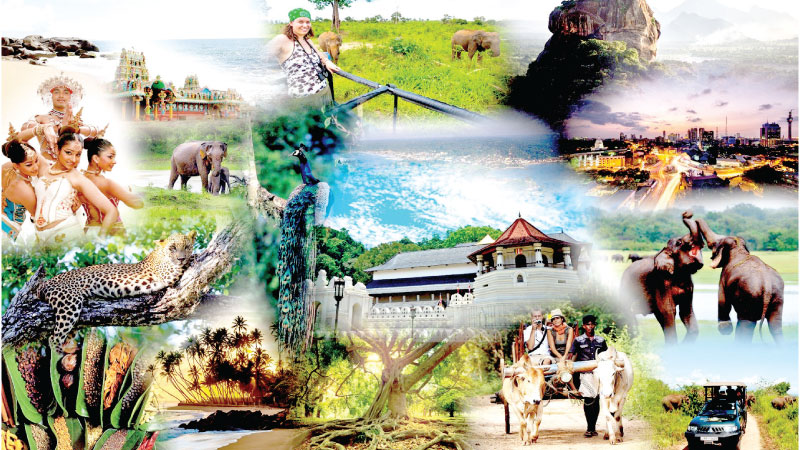 Why was Malaysia voted by a reputed tourism publication as Asia’s most loved country? Also the thriving travel-hub was Asia’s number one tourist destination year before last, though displaced by Thailand in 2024.
Why was Malaysia voted by a reputed tourism publication as Asia’s most loved country? Also the thriving travel-hub was Asia’s number one tourist destination year before last, though displaced by Thailand in 2024.
Malaysia, unlike Sri Lanka, however, makes most of its tourism revenue with high-end tourism. Many Singaporeans and Chinese visit Malaysia to indulge in luxury shopping, and to play golf at swanky resorts.
Why isn’t Sri Lanka following suit one may ask? The question has a corollary. Why is Malaysia which doesn’t seem to have half the attractions that Sri Lanka has — from beaches to the most amazing scenic locations and ancient ruins to boot — still far ahead of Sri Lanka when it comes to tourism?
pampered
The same could be asked of the Maldives and Thailand, but the Maldives caters to a very specific luxury-tourism market and that’s only too well known. Not so Malaysia. The country doesn’t have isolated island resorts where tourists could be pampered, with almost nobody else in sight. But yet, Malaysia is a top tourist destination, earning the appellation ‘most loved’, and drawing the most number of tourists in Asia.
That’s mostly because Malaysia caters to the well-heeled, and not the typical backpacker tourists who take the route to Bali and Sri Lanka, and perhaps Vietnam.
Can Sri Lanka be a high-end tourism magnet such as Malaysia, for the simple reason that we have been economically disadvantaged? We certainly do not have the purchasing power the Malaysians have, that enabled Malaysia to have those well appointed department stores, the heavily patronised golf links, and the lot.
So, it is seen that Malaysia can be high-end because the Malaysian economy provides high-end options for its citizens.
In other words, the rich want to go to Malaysia, partly because Malaysia is relatively rich, and certainly we do not have that default advantage. Does that mean that we have to forgo high-end tourism altogether?
It seems slightly odd that Malaysia, a country that doesn’t have natural attractions — at least in the proportion we do — outdoes almost every other country in the region in terms of tourist arrivals, simply because that country has acres and acres of Department Store shopping.
But can’t we as a tourism destination that is rich in attractions, do high-end tourism at least in patches until we reach the economic standards of say Malaysia, or Singapore?
We could create a high-end niche market, the kind that the Maldives has famously succeeded in establishing. We could, of course, also take a tip from Malaysians and improve our economy fast.
Though that sounds facetious, nothing spawns a high-end tourism market more than an economy on steroids. But if the economy is poised to improve, we need the plans to go with that.
It doesn’t appear that high-end tourism is on our radar even as a futuristic possibility. That’s a very linear mindset, unfortunately.
We need some high-end enclaves, replete with golf courses, mouth-watering shopping options, and variable cuisine. As a nation, are we up to it? Perhaps we have too many reservations about issues such as gambling and liquor. It has happened before.
We can’t create a Macau because there are a myriad cultural reservations. So, as a country we are masters of self-sabotage when it comes to exploring all possibilities.
The Malaysians, of course, had the money to go over the top and create iconic attractions, but it is doubtful we could have come up with a project such as the Petronas Towers even if we were cash flush.
We couldn’t have escaped the accusations of wretched excess by the commentariat. That way, we don’t have the right mentality. We want to build a Dubai with Cuba-like basic instincts.
Vietnam has a sizable luxury tourism segment. It doesn’t rely on a few key locations such as the Galle Fort. Apparently, since foreigners started buying property in the Galle Fort, Sri Lanka, according to some writers, transformed into a ‘luxury tourism destination.’
This writer finds it difficult to agree with that take. A cultural heritage site liked by foreigners, doesn’t a luxury travel paradise make. In Vietnam, when the planners discovered that South Korean tourists like golf-tourism, they came up with golf-resorts that can be accessed via helicopter transfers.
In the end, it is about having the money and spending it, and the Vietnamese economy has developed to a point at which these options are par for the course, no pun intended.
Sri Lanka also seems to have this unhealthy tendency of treating tourists as a breed apart. Tourism-apartheid is often spoken about in this country.
Attitude
In Malaysia, they don’t treat the Singaporean tourists as being of a special breed. Of course, the two countries are kin in more ways than one, yet it would be easy for Malaysians to fawn on the successful Singaporeans, but they do not. Malaysians know they are almost as successful, and do not hold South Koreans, Singaporeans, Taiwanese or anyone in awe. This type of matter of fact attitude is unfortunately absent when it comes to most Sri Lankans. In this country, we seem to want our tourists to land from Mars, spend as if they were literally from out of this world, and then quietly vanish.
This attitude would not have prevailed, if more Sri Lankans had been rich enough to enjoy luxury destinations themselves. But, of course, our economy hasn’t allowed that.
People pay too much taxes, and they can’t make their incomes stretch, and it is an old story. It is obvious that the richer the country, the richer the types of tourists who visit. In one sense, we have got it the wrong way around. We are relying on tourism to make us rich. But if we set about becoming rich as in creating a booming economy, the tourists would saunter in anyway, and that’s guaranteed.
Besides, tourism markets such as South Korea, Taiwan, Singapore, and even China, have to be carefully studied if we are to create a high-end niche at least, never mind a high-end market that could rival Malaysia.
The other aspect, of course, is the infrastructure. Malaysia is ideal for high-end tourism because helicopter transfers are made easy, and there are great transport facilities, including a fully functional state-of-art subway system.
Again, it is the money that has been pumped into the economy. We do not have that advantage, and would have to make do with sometimes messy road transfers and such others that tourists looking for a luxury getaway don’t necessarily like.
Even little enclaves such as the Mauritius and Seychelles have thriving high-end tourism markets. About five percent of the tourists visiting Mauritius visit for its golf courses.
Think about that. This is a small place, with barely two million people in all. But there is more golf tourism in Mauritius than the luxury tourism paradise, the Maldives. Again, the hard fact is that Mauritius has a significantly higher per capita GDP than Sri Lanka.
So, the country is richer, and has the potential to cater to richer tourists, and they haven’t got their thinking upside-down either i.e: that rich tourists should drop in and make the country rich. Of course, Mauritius has been able to invent themselves as a tourism paradise, and that’s contributing to an economy that’s more than a fair measure ahead of Sri Lanka in key areas such as technology, and financial services.
All that aside, Sri Lanka can create a niche-tourism market if we can attract the investment and plough in the money.
One way of doing it is to create the image. The Maldives did that with their luxury resorts. The other hard truth about luxury tourism is that it has to be driven mostly as a ‘man-made’ product.
We have nature’s bounty, but unfortunately that’s not enough to capture the luxury-traveller market. The work has to be put in. Golf courses, abundant choices in cuisine and the entire lot, needs to be put in place. When it comes to putting in the work, Sri Lankans seem to wait for others to arrive and work the magic. But the high-end tourism dream will remain a dream, unless we put in the hard yards.









